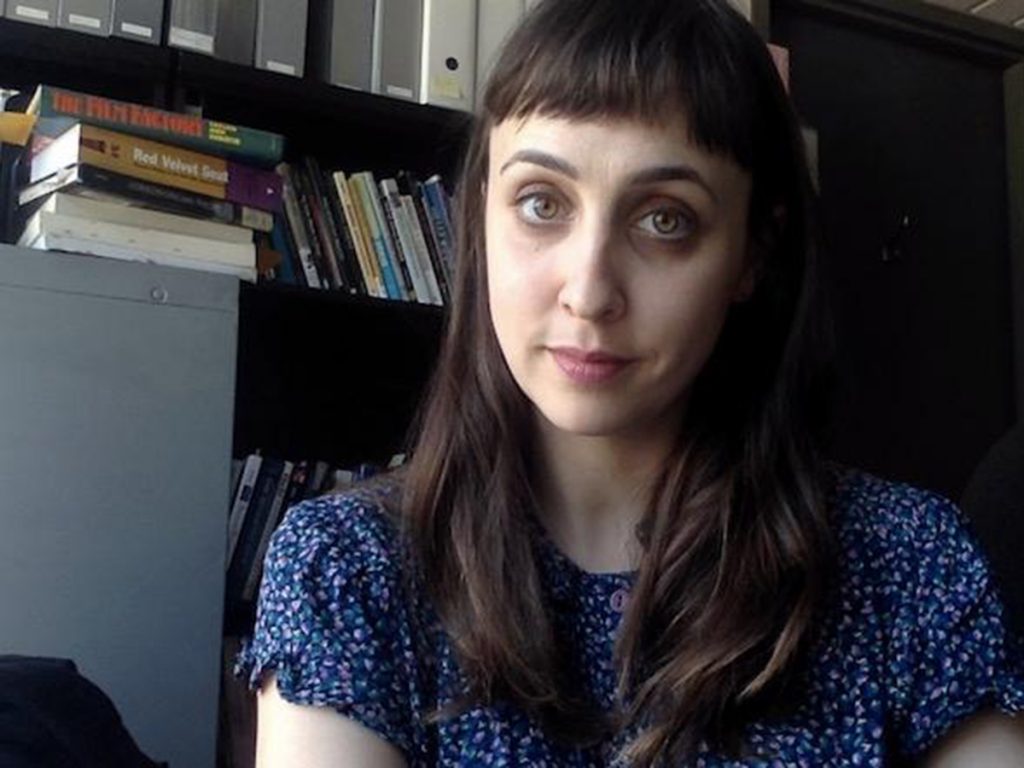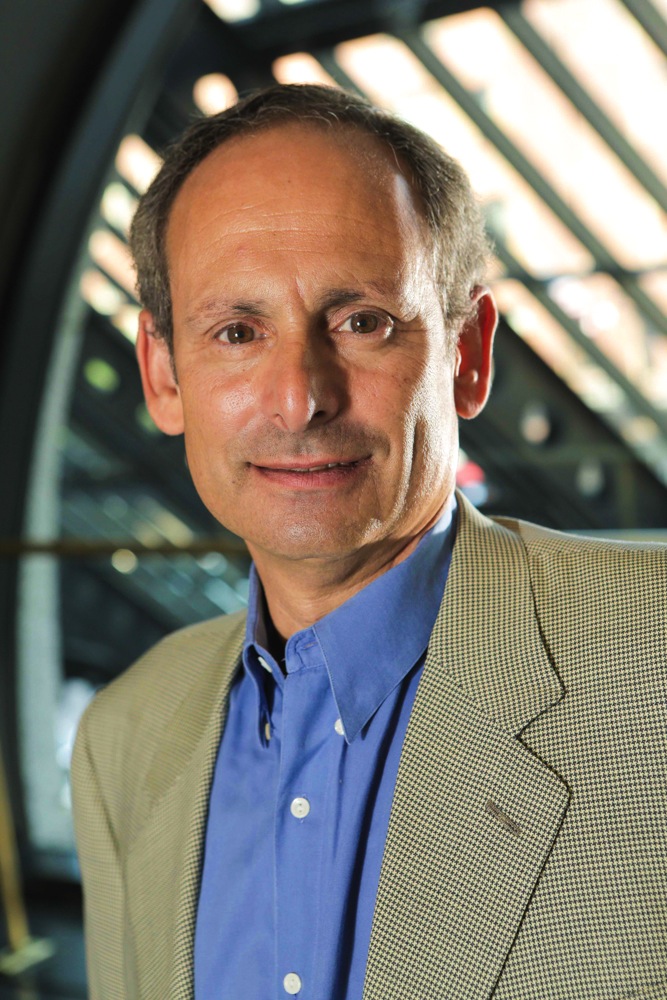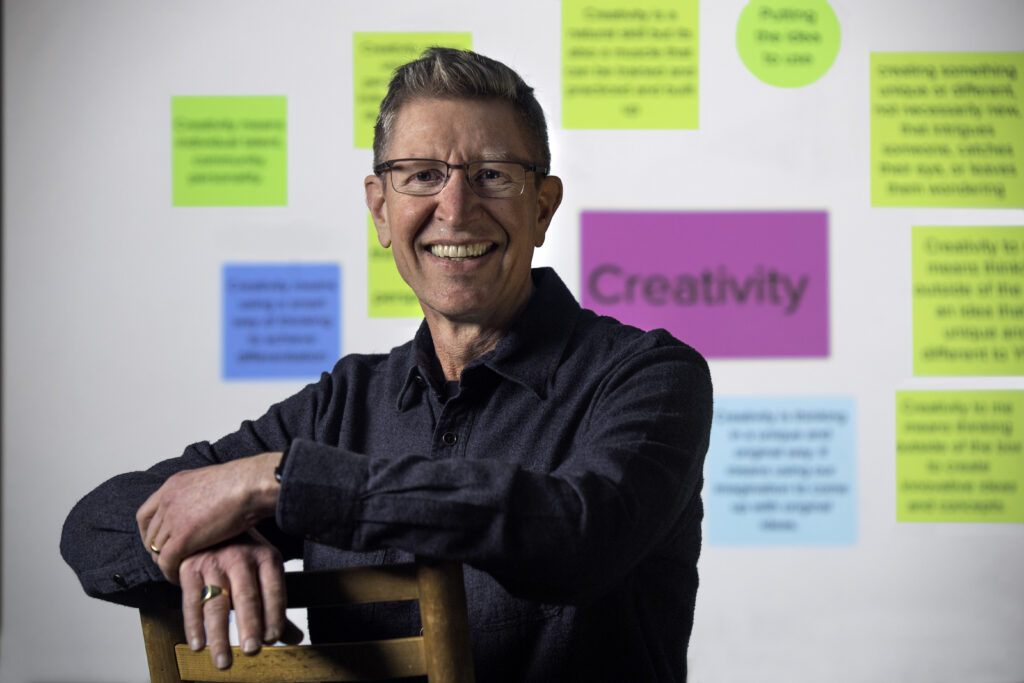Terrific Trio Tapped for Emerson Teaching Awards
With a combined 50-plus years of teaching at Emerson College, this year’s teaching awards recipients have shaped generations of Emersonians who have found success across a wide range of industries.
“We received over 200 nominations this year, which shows the degree to which excellence in teaching is recognized and appreciated at Emerson,” said Provost and Vice President for Academic Affairs Alexandra Socarides.
The process for selecting the winners involved reviewing nominations by the deans and then consultation with the Gold Key Honor Society officers, the donors of the awards, and (in the case of the Alumni Award) the Leadership Committee of the Alumni Board.
The Helaine and Stanley Miller Award for Outstanding Teaching goes to Maria Corrigan, Assistant Professor in Visual and Media Arts. The Alan L. Stanzler Award for Excellence in Teaching goes to Randy Harrison, Senior Affiliated Faculty in Marketing Communication. The Alumni Award for Teaching Innovation goes to Thomas Vogel, Professor in Marketing Communication.
They will be receiving their awards at the Gold Key Society Induction Ceremony on Wednesday, April 2, at 4:00 pm in the Semel Theater.
Q&A with Maria Corrigan, Randy Harrison, and Thomas Vogel

Maria Corrigan
What does receiving this award mean to you?
Corrigan: It is an enormous honor to receive this award. I’m very grateful to be recognized for the work I have put into teaching during my time at Emerson.
How do you bring excellence to your teaching, whether through media studies and comedy courses or co-directing Emerson’s Global Pathways London program?
Corrigan: This is a tricky question to answer since I’m not always certain that my teaching is excellent. I don’t mean this as false modesty either – I’m quite confident in my teaching abilities, which have been tested over and over again through different crises, including the pandemic. I simply mean that teaching is a dynamic, ever-changing process. What works with one batch of students is not guaranteed to stoke the interest of another batch of students. This can sometimes shift over the course of years, but I’ve also seen it shift in back-to-back classes.
Instead of striving for excellence, I try instead to maintain a level of flexibility, while upholding academic rigor. In every class, I have a goal in mind, but getting to that goal requires flexibility, listening to the students, and a willingness to try new things. A sense of humor is invaluable, since play is so important to the learning process. It also helps when classroom experiments go awry, since laughing at yourself is a useful way to model small-scale failures in front of our students, who can often be scared to try things out.
How do you keep students engaged and inspired in the classroom?
Corrigan: Another tricky question! This semester, I’m teaching 200 students across two sections of VM133 Foundations Colloquium, and I can say with certainty that my lectures are never 100 percent inspiring across the board. But I wouldn’t be doing my job if I were trying to keep everyone entertained. In fact, as a media studies professor, I am aware that I am often teaching what may be considered to be the vegetables on the plate of media production students, who are impatient to be making things.
But learning can often be an uncomfortable process, and one that continues outside the bounds of a lecture or a screening. This is one of the teaching challenges that I relish most, as it is extremely rewarding to introduce students to texts and critical approaches that ultimately transform their views on art.
Whatever the level of the course, I approach the classroom with three basic goals in mind. First, I believe that any artwork, or any critical or theoretical text, expresses a way of seeing the world. I strive to equip my students with the tools to understand the aesthetic, social, historical, theoretical, and ideological underpinnings of these expressions. Second, a fundamental aspect of my task as teacher is to create an environment for dialogue, where students can express themselves in relation to the expressions studied in class. Third, I wish to engage the students in questioning the structure of the curriculum and the field, asking them to question (rather than merely receive) the monuments of media history and theory.
What is your favorite assignment to give students?
Corrigan: As much as I love a well-written, thoroughly researched essay, I love finding ways to bridge perceived divisions between theory and practice, so my favorite assignments ask students to use their creative skills to approach intellectual, critical questions in the field.
Over the years, my Emerson students have repeatedly risen to the challenge, whether it’s a first-year history group of students who explain the tenets of Italian neorealism by restaging moments of Bicycle Thief, or another group of Colloquium students who critiqued power structures on film sets within a hilarious and incredibly produced spoof of Hitchcock’s Rear Window. I’ve seen truly excellent video essays produced in VM200 Media Criticism and Theory by students who apply feminist and/or global perspectives to the study of their favorite video games.
I am happy when students grapple with challenging or difficult material, but I’m always delighted when my students show a willingness to play around with weighty concepts from class to see how applicable these ideas are to their own media landscapes.
Randy Harrison

What does receiving this award mean to you?
Harrison: I am deeply honored to receive this award in more ways than I have words to express. I started teaching here at Emerson in the fall of 2002. As a marketing strategist, I had a thriving solo marketing consulting practice focused on B2B and eBusiness, coming off my best year yet, delivering $2 billion in revenue to one of my clients, and my rates growing exponentially. Then the infamous dot-com bubble burst. Marketing departments everywhere were some of the first to go, and even with those results, I was let go.
This brought up a serious question. If, as I believed and practiced, marketing [and] innovation were the keys to value creation – just as the godfather of modern business, Peter Drucker, told us in the 1940s – I wanted to explore why, then, was marketing treated as an expense, which of course means being cut when revenues drop. Addressing this question was and still is my north star.
When the opening to teach here arose a couple of weeks before classes in August 2002, I leapt at it. I saw teaching as an opportunity to, in some small way, enrich the profession I love by helping develop raw young talent into self-directed, highest-performing marketing professionals that not only knew the marketing principles and how to develop strategies to set the playing field to win, but also to achieve the results that matter to executives, such as competitive advantage, shareholder value, and profitability.
So, to answer the question… my classes are immersive and experiential. I hit the ground running from Day 1 each semester. It’s exhilarating to see students transition from that wide-eyed look of feeling overwhelmed to the ‘aha’ moments of getting it a few weeks later. And I challenge and get to see students reveal their self-directed ‘A-player’ selves too, breaking free of always being told what they need to lean and starting to take that on for themselves guided by their own curiosity.
But what I don’t see is the impact in the wild… the impact my students have making the unique contribution on the job, their ‘dents in the universe.’ Sometimes a student reaches out, often years later, and they catch me up on what they have accomplished… and sometimes they pop up in my LinkedIn feed. And I go, ‘WOW… look at what these amazing folks have done.’ And they have, raising to the top ranks.
What makes this award so special to me is that this impact is revealed much sooner than I ever realized, a delightful, beautiful surprise! I will cherish this award and what it means in this regard forever, for which I am grateful beyond measure.
How do you bring excellence to your teaching, whether through teaching marketing strategy, leadership or management?
Harrison: Always learning, evolving, and adapting! All of us are living in a world being transformed by innovation moving at an exponential pace. The only way I know to ‘skate on the ice,’ and in this case, keep my classes relevant as well (AI anyone?) is to stay curious, and open, and constantly experiment, and yes, fail too.
I also bring, in no small measure due to being a dad, the growth mindset to all my classes. For example, I work with students a lot on professional and career development and what it takes to be successful. I know that being an A-player or lifelong learner is not a genetic thing bestowed upon us by a higher power from up above. It is learned skill and a gift we give ourselves, and this is somehow baked into all I do in class.
One other thing – my role as a teacher has changed. Just like I learned in high tech, I am not the beneficent sage extolling my wisdom from on high on my students. Especially in a world where we are all learning, I see my role as an enabler and facilitator, a curator and guide focused on empowering students with learning experiences they can draw upon to fulfill their career goals.
Over time and with the support of my family, colleagues and the students themselves, I keep getting better at it!
How do you keep students engaged and inspired in the classroom?
Harrison: Enthusiasm. I love this work! And I also learned long ago that if I am low-energy, so are my classes, and therefore so are the students. So I try to make each class interactive, entertaining, and even fun, as well as informative and challenging. Truth be told, teaching for me is also a performance, so bring it on!
What is your favorite assignment to give students?
Harrison: There are lots, but a couple stand out.
First, I have students work on three projects using on the case study method of learning by teaching. Here the students have the space to ‘get behind the controls’ to teach the rest of us what they have learned and by doing so, without them necessarily knowing it, anchoring and internalizing marketing principles. By the way, a few years ago, I tried to cut back to two projects but the end results weren’t as strong, so three’s the charm!
The other is one of the final semester assignments I recently added called Purpose v.2, Your Compelling Reason to Buy, where I pose the million-dollar question: ‘Why you?’ In this assignment, students are tasked to identify the next internship or job they want, and then answer that question, with the assumption that there are lots of other folks like them – bright, talented, and enthusiastic – who are also applying. Why would I hire you, and not them? How are you different? And why should the hiring person care?
I love this one because each student has to draw on everything we have learned together, plus find the confidence in themselves to be willing to stand out and declare it, which is what marketing strategy is all about. Again and again, I see that when they get there – and it is a learning process, or what I call as a consultant, a ‘journey of discovery’ – then, just like as Dorothy in The Wizard of Oz finds out when her house falls on the Wicked Witch of the East and she opens this door, a whole new and fantastic world awaits them.
Thomas Vogel

What does receiving this award mean to you?
Vogel: I very much appreciate the fact that my work is being noticed by others. Based on my research and my teaching evaluations, I am aware that my students typically associate a benefit with the classes they take with me. But receiving an award for my teaching takes the external validation to a new level. While I have a strong intrinsic motivation, this award provides wonderful positive energy and support to continue my work and keep exploring, experimenting and taking risks.
How do you bring innovation to your teaching, whether it’s about international advertising, digital marketing, communication, or the creative process?
Vogel: Innovation relates to my own personal curiosity and creativity. I have always been blessed with the ability to think differently and come up with new, and often different ideas, but it takes a team to turn some of those ideas into reality. Also, innovation requires ‘buy-in’ and the help from collaborators such as my students, colleagues, and my business partners to ‘execute creative ideas’.
Having co-founded several companies and been involved in and affected by the economic ups and downs of agency life (real business), I know that change is constant and often surprising and unexpected, and we cannot plan for everything. This constant change requires looking at problems and challenges from different angles and adding different perspectives, resulting in the ability to pivot and reframe challenges.
Understanding the creative process and applying a creative process has helped me tremendously in my teaching, research, and professional work. At the beginning of the creative process and many projects, there is the unknown, the ambiguity, and the feeling that one doesn’t know what to do. But doing research and applying a creative process by being aware when to apply divergent and convergent thinking has helped so far.
Added to that is the fact that change is constant and that new technologies, while fascinating, emerge on an ongoing basis and often throw you a curveball. I am fascinated by new technology and try to implement it into my work and teaching as often as possible.
Lastly, engaging in scholarly work, doing research, following other people’s research, attending academic conferences, learning new skills (e.g becoming a certified facilitator of the Lego Serious Play methodology), observing other creative individuals’ and groups’ work in almost any field, and staying connected to my agency and the companies I have invested in, provide the nurturing ground and backdrop for my work/teaching/life.
How do you keep students engaged and inspired in the classroom?
Vogel: I am exposing my students to the research and theoretical frameworks (old and new) related to creativity, as well as professional examples. Then, I provide a platform for my students to experience what we study so that they can apply personally and individually what they learn. Then, there is a lot of reflection and self-reflection, and we are building and creating a community so that they get to know each other closely. This leads to a collective awareness and the recognition that everyone is creative – but in different and individual ways.
Then, there is the realization that other ideas developed by classmates can be cool too, and are often unexpected. Additionally, I am trying to allow my students to develop [creative] agency so that they have a say in what we do and sometimes how we do it. Additionally, they typically increase and/or develop their own confidence leading to creative self-esteem. Ultimately, it’s about encouraging my students to unleash their own intrinsic motivations and to follow their passions.
My role as a teacher has shifted in recent years from teacher to educator, and that of an expedition guide and coach. We are going on a journey together as a team. The journey is the reward.
What is your favorite assignment to give students?
Vogel: Two horses and two riders. This exercise/puzzle requires divergent and convergent thinking and ‘thinking outside the box’.
Typically, there is a big ‘aha-effect’ when one reaches the correct answer, and this exercise illustrates that we have to become aware of our auto-pilot thinking and move our mind and thinking into a ‘mindful’ and powerful thinking machine that can be directed and redirected and that is capable of shifting perspectives hundreds of times, as well as reframing many problems and challenges.
Categories